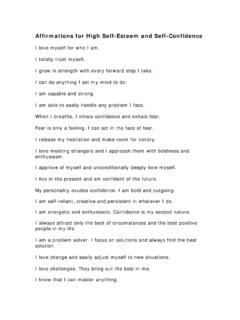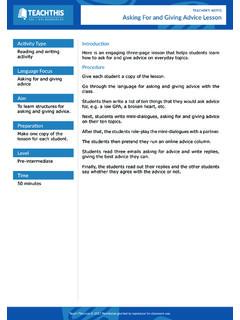Transcription of Instructor’s Manual - Jack Canfield
1 instructor s Manual For Conducting a Success Principles Study Group or Workshop The Success PrinciplesShort Course instructor s Manualby Jack CanfieldThis guide is a companion publication to the New York Times Bestselling Book:The Success Principles How to Get From Where You Are to Where You Want to BeBy Jack Canfield with Janet SwitzerHarperResources, 2005 This instructor s Manual is a publication ofThe Canfield Training GroupP. O. Box 30880 Santa Barbara, CA 93130 (805) 563-2935 (805) 563-2945 For additional resources and updated reader s information, visit 2015 by Jack Canfield and Self-Esteem Seminars. World rights Success Principles is a trademark of Self-Esteem leader s Manual may be reproduced for non-profit use to provide training in the application of theprinciples and strategies for success contained in the book The Success Principles.
2 How to Get fromWhere You Are to Where You Want to Be by Jack Canfield with Janet Switzer in homes, churches, schools,businesses, non-profit organizations and professional associations without written permission from the authorand copyright part of this publication my be reproduced, transmitted, stored in a retrieval system or translated into anylanguage or computer language, in any form or by any means, electronic, mechanical, magnetic, optical,chemical, Manual or otherwise for profit without prior written permission from:Jack Canfield / The Canfield Training Box 30880, Santa Barbara, CA 93130 (805) course is meant to help people integrate and apply the principles and strategies of success presentedin The Success Principles: How to Get from Where You Are to Where You Want to Be by Jack Canfieldwith Janet Switzer (New York: Harper Collins, 2015).
3 The book is available at all bookstores and on theInternet at , and other online leader s guide has been written, compiled, typed, edited and formatted by Jack Canfield , JesseIaniello, Kacie Mutschuller and Janet 4 Session 1:Getting StartedAsk participants to read Chapters 1, and 3 of The Success Principlesbefore the session. Make sure you read and understand them 1: Take 100% Responsibility for Your LifeE+R=OChapter 3: Decide What You WantVisionYou can work with any size group. If the group is larger thaneight people, I suggest you break the group into smaller groups of4 members each within the same room. Adjust as necessary to fityour situation. Have the groups sit in sure everyone has a pad of paper and a pen or that they purchase a journal or notebook especially fortheir notes in this class.
4 Ask that they bring it to each class, sothat they can refer back to what they have written in later to the group: We are going to start by having eachmember introduce yourself, what you do for a living (what yourjob in the company is, etc.), and something you are proud of havingaccomplished. Make sure every member has access to a copy of The SuccessPrinciples. Ask how many people have read chapters 1, 3 and them not to worry if they haven t read the chapters. Ask themto read them, plus chapter 10: Release the Brakes and chapter 11:See What You Want, Get What You See before the next sessionRemind them of the formula E + R = O(Event + Response = Outcome)Tell them: We are going to work on taking more responsibilityfor our lives, which is the first and most important step towardcreating more success in our lives.
5 OPTIONAL INTRODUCTORY TALK:If you want, you can read or paraphrase the followingintroduction to key principles we are covering here today are 1) youhave to give up blaming and complaining. We spend most of ourtime blaming things outside of us-the weather, our boss, the trafficthat made us late, the economy, or the current president. Whateverit is, we tend to blame something outside of ourselves. 2) Thesecond thing is that you have to give up all your excuses and takethe position that whatever you re experiencing in life, the resultsyou are creating (whether it s physical, financial, or relational),the quality of life you are experiencing is a result of how you areresponding to the events rather than the events themselves.
6 Theformula that captures this is E + R = O. You might want to writethat + R = O stands for Event + Response = Outcome. And whatmost people do is when they don t get the outcome they want,they blame the event. When they blame the event for not havingwhat they want, it puts all of the power outside of them. There isnothing you can do about external events. What is just is. Sowhat you have to do is change your response to get the outcomeyou want. So 2 + 2 = 4. If you don t like 4, the 2 of the event isa given. You ve got to change your response from a 2 to someother number, say 3 or 4 or 5, in order to get a different result. Sothe basic principle is getting yourself out of blaming andcomplaining and into taking important concept is that people tend to complain tothe wrong person.
7 If I m upset at Patty, I tell Veronica. And if I mupset at Veronica, I tell Patty. That doesn t solve anything. I needto tell Veronica if I m upset at her or Patty if I m upset at her-sothat the person who can do something about it has the feedbackthat I would like something different. That person doesn t need togrant my request, but at least I need to communicate a request inorder to get what I important concept in taking responsibility and notbeing a victim in life is something called a yellow alert. Yellowalerts are things that you notice in your life that act as clues thatthings are happening or about to happen that aren t going to workout. Like, I hire Sarah and she says, Oh yeah, I m thinking aboutmarrying some guy who lives in the Bahamas, and we ignorethat.
8 On another day she says she really is falling more in lovewith the guy and she hates the rainy weather in here in then all of a sudden she quits and we re surprised and leftunprepared because we weren t paying attention to the yellowalerts she was giving us all along. There are lots of yellow alerts inyour life like your husband comes home with lipstick on hiscollar or he s late every night and you wonder well what s goingon here? Well I don t want to say anything about it because thatwould be too uncomfortable. Because it is inconvenient oruncomfortable, we tend to deny the yellow alerts rather than toact on them. So we almost always have clues that things are comingand so we re not the with that in mind we are going to do an :Ask the group to get into groups of 4 or 5 or 6 (whatever isappropriate for the size group you are working with).
9 Larger than6 will take up too much s best to have the following sentence already printed out ona flip chart, poster, PowerPoint slide, white board or chalkboard:If I were to take just 10% more responsibilityfor my life I them to go around the group in order, from right to left,completing the following sentence:If I were to take just 10% moreresponsibility for my life I them that they are to keep going around the group, takingas many turns as time allows, completing the sentence. Tell themthat you will give them about 4 minutes for the 5 Here are several more sentence completion they can do. Youcan do more or less depending on the amount of time you haveallotted for the group I were to take just 10% more responsibility formy happiness, I I were to take just 10% more responsibility formy health and fitness, I I were to take just 10% more responsibility forthe quality of my relationships, I I were to take just 10% more responsibility formy effectiveness at work, I I were to take just 10% more responsibility formy happiness, I the completion of the exercise (completing several differentsentence stems), say: Now look at what you ve said and what you ve heardfrom all of us and think about two things.
10 First, does anyonesee any common themes? (Participants respond.) And,second, based on that, what s one action you would bewilling to commit to taking before our next session thatwill put into action any one of those things that you cameup with?It doesn t have to be a huge gargantuan thing, it can be taking30 minutes in your room by yourself because you said I wantmore time for me or whatever. Write it down so you capture it,and then let s go around the group and say it out loud so you hearyourself committing to it - so we can hold ourselves accountable,and so that when we come back tomorrow, we can ask ourselves, Did I do that? Because what we are finding really makes thedifference is not what we know.



